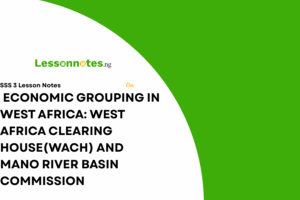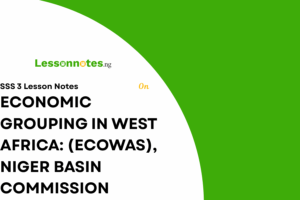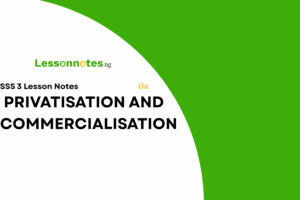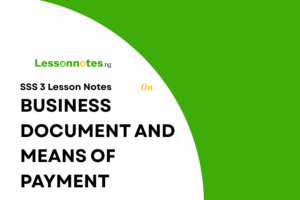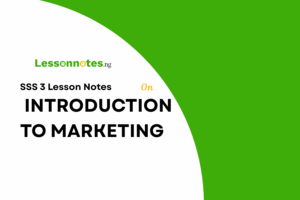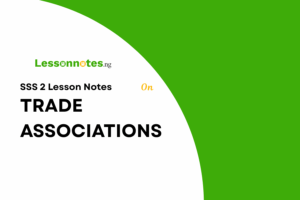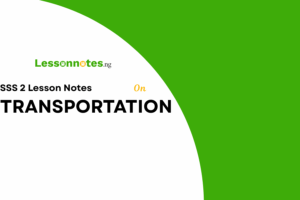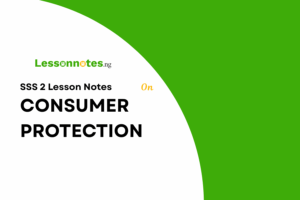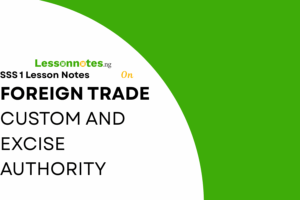Insurance SS2 Commerce Lesson Note
Download Lesson NoteTopic: Insurance

Insurance is an agreement whereby one party promises to indemnify (pay or provide financial compensation for) another party a sum of money in the event of suffering a specific loss/damages. Insurance is one of the aids to trade.
TERMS ASSOCIATED WITH INSURANCE
- Assurance: This is the provision of cover against some eventuality which must occur at some time in the future.
- Notes: The major difference between Insurance and Assurance is that in Insurance the risk insured may NOT occur while in Assurance the risk is CERTAIN to occur.
- Underwriting: This is the process whereby a merchant of an insurance company undertakes to cover, underwrite a portion of a risk or assume part of a risk which ordinarily, another insurance company had covered.
- Reinsurance: This is whereby an insurer agrees to insure with another insurance company all or part of the risk. Large risk is spread among many insurance companies leading to a reduction of losses. In Nigeria, there are specialized companies that handle this line of business such as Nigeria Reinsurance, African Reinsurance and Continental Reinsurance.
TYPES OF INSURANCE
There are two types of Insurance: Indemnity and Non-indemnity.
- Indemnity Insurance – This is the type of insurance in which the insured is restored to his former position before the incident occurred, by receiving compensation.
- Non-indemnity Insurance – This type of insurance refers to those associated risks for which no amount of compensation could equate to the loss suffered by the insured.
BASIC PRINCIPLES OF INSURANCE
- Pooling of Risks: This is the principle where one party (insurer) collects premiums from a group of people that suffer similar risks to create a common fund out of which compensation is paid to those that suffer losses or damages.
- Utmost Good Faith: This is the principle used in insurance contracts that legally obliges all parties to reveal to others all important information relating to the contract – the standard of honesty greater than that usually required in other business relations.
- Loss/Damages: This is a reduction in asset or property value or damage of the said asset or property due to an accident, natural disaster, man-made disaster or other risks.
- Proximate Cause: This refers to the nearest cause to the loss or the direct cause of a loss.
- Abandonment: This principle states that property that has been insured may be abandoned in certain cases if its actual loss appears to be unavoidable or if the cost of repairing the damaged property will exceed its value.
- Subrogation: This principle provides that once an insurer has indemnified for loss, the insurer can take over the specific asset and the rights relating to it.
- Contribution: This principle states that where a person suffers a loss from a risk insured with insurance companies, he cannot claim compensation in full from each of the insurance companies. Each of the companies can only pay a certain proportion of the loss.
- Premium: This is the payment made to an insurance company by the insured for an insurance policy or cover. Such payment can be made weekly, monthly or annually depending on the agreement.
- Idemnity: This is the compensation given to the insured by the insurer in the event of his suffering a loss.
- Insurable: This principle states that one can only insure properties that will bring loss or liabilities to him upon destruction. The insured can only be the owner of the property.
GROUPS OF INSURANCE
There are two groups of Insurance: Life Insurance and Non-life Insurance
- Life Insurance – This is the aspect of insurance that protects against the loss caused by the death of a person. It is divided into four different types which include:
i. Whole Life Assurance – This type of insurance policy lasts for the lifetime of the insured (the person that holds the policy) and the sum assured is only paid at death. The insured pays the premium throughout the duration till death.
ii. Endowment Policy – Here the sum assured is paid either after a fixed number of years or at death whichever comes first.
iii. Term Assurance
iv. Annuities
- Non-life Insurance – This is the branch of insurance which is taken as a protection against the loss of properties and other valuables. There are many types of this that include:
i. Motor Vehicle Insurance – This policy covers provides for liability for death, bodily injury to any person resulting from the use of the vehicle on the road or damages to the vehicle as a result of fire and theft. The types under this policy include:
a. Third Party Fire and Theft Insurance
b. Comprehensive Insurance.
ii. Fire Insurance – This is a type which includes cover for loss or damage caused by burning. Fire insurance can be with an Average or without an Average Clause.
iii. Fidelity Guarantee Insurance – This is a type of insurance covered by an employer insuring him against the possibility of the dishonesty of an employee. This is taken by a company against loss because of the dishonesty of people holding positions of trust.
iv. Burglary/Theft/Accident – This insurance policy provides compensation for losses arising from insured goods or property stolen or damaged through breaking into a premises/shop of a business or an individual.
v. Consequential Loss – This insurance policy covers losses to commercial firms after a fire incident resulting in stoppage of production /other business activities. This will includes loss of profit etc.
vi. Marine Insurance: This is a branch of insurance which covers losses or liabilities relating to ships and their cargoes against the dangers in the sea. The dangers in the sea include storms, tempests, collisions, theft, fire, etc.
Types of Marine Insurance – The Marine insurance includes:
– Hull Insurance – This insurance policy covers the ship against damages resulting from
the dangers of the sea.
– Cargo Insurance – This insurance policy covers the goods or cargo carried by the ship while in transit.
– Ship Owners Liability – This insurance policy covers all risks for which the owner of a ship or the employees are liable and these include the cargoes, the passengers, crew members, and fixed installations at wharves and beaches.
– Freight Insurance – This insurance policy is taken to cover against refusal to pay charges for lifting the goods.
Marine Insurance Policies
Some of the policies include:
- Time Policy – The insurance policy covers the ship and cargo for a specific period usually a year.
- Voyage Policy – This policy covers a specific voyage/route any deviation from that route will not be covered e.g. Lagos – Accra.
- Floating Policy – The policy covers any shipment made by the holder provided the precise amount of each shipment is declared by the holder.
- Valued Policy – This policy entitles the holder to receive the specified amount of the good irrespective of the value at the time of loss.
- Unvalued Policy –This provides for claims based on the value of the good at the time of loss while the original value is irrelevant.
d). Marine Losses – This can be categorized as Total or Partial Loss
- Total Loss – This is the actual total loss which occurs when the goods a destroyed by fire, the ship sinks, goods are no longer fit for the intended purpose or what is left can not be of any economic value.
- Partial Loss – This occurs when some of the goods are deliberately and reasonably thrown overboard (jettison) to lighten the ship to reduce loss. This also occurs when the ship or cargo suffers partial loss or damage.
RISKS IN INSURANCE
Classes of Risks in Insurance
There are two classes of risks viz Insurable and Non-insurable risks
- Insurable Risks – This class of risks are which the insurer can make provisions for insurance because it is possible to collect, calculate and estimate the likely future losses. Examples include Motor, fire, etc
- Non-insurable Risks – This class of risks which the insurance company is not ready to insure against because the likely future losses cannot be estimated and calculated. Examples include gambling, risks due to war, etc.
Types Of Risks In Insurance
There are many types of risks, four of these include:
- Fundamental Risk – This type refers to the risk which arises due to the causes which are not under the control of any person.
- Particular Risk – This type of risk refers to the risk which arises mainly because of the actions or the interventions of the individual or group of individuals.
- Speculative Risk- This type of risk refers to a situation where the direction of the outcome is not specific. This means it leads to a condition of loss, profit, or break-even.
- Pure Risk – This type of risk refers to the situation where it is certain that the outcome will lead to loss of the person only or maximum it could lead to the condition of the break-even to the person but it can never cause profit to the person.
PROCEDURES FOR INSURANCE CONTRACT.
- The potential client (the insured) obtains a PROPOSAL FORM after INQUIRY, fills the form providing all relevant information and submits it.
- The PREMIUM stated in the form will be paid to the insurance company on a weekly, monthly or yearly basis.
- The insurance company will issue a temporary cover called COVER NOTE and after processing will issue out the INSURANCE POLICY which gives details of the insurance.
IMPORTANCE OF INSURANCE BUSINESS
- It facilitates trade both local and international.
- Insurance cover leads to risk reduction.
- It provides security to commercial activities.
- It serves as collateral security that can be used to obtain loans from the bank.


